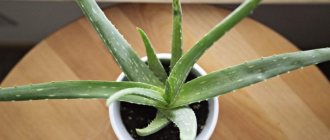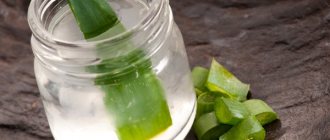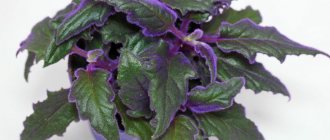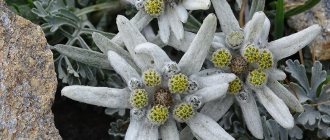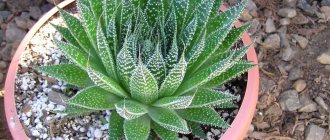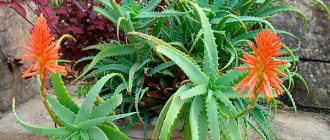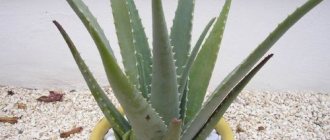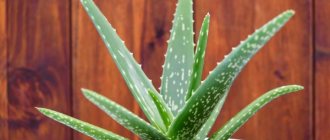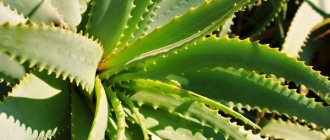Variegated aloe (Gonialoe variegata, formerly known as Aloe variegata) is a perennial herbaceous succulent from the genus Gonialoe, family Asphodelaceae. The genus Aloe was found to be polyphyletic and was divided into the following genera: Aloe, Kumara, Aloiampelos, and Gonialoe. The plant received its name for the variegation of its leaves. Other common names: Aloe tiger, Aloe spotted, Aloe striped.
Details about aloe variegated (tiger)
Aloe variegated or tiger is an ornamental plant that is grown in flowerpots and in open ground.
The succulent got its name due to the peculiar coloring of the leaves, on which contrasting white stripes or spots are formed. Appearance of a young plant
Variegated aloe is unpretentious to soil and natural conditions and grows well in different climatic zones. Caring for it at home is also quite easy. The plant does not require frequent watering and thrives both on a sunny windowsill and in dimly lit rooms. Aloe variegated is one of the few species that bloom at home, however, the first inflorescences appear only in the 4-6th year of the succulent’s life.
In folk medicine, it is believed that the juice from the leaves of aloe variegated has bactericidal properties and promotes the healing of wounds on the skin. However, this data has not been scientifically confirmed, so the benefits of the plant remain only speculative. For medicinal purposes, juice or tincture from the leaves of aloe vera, homemade or tree-like, as well as occasionally striped and several other species, is used. The properties of aloe vera have been studied the most. Variegated is grown only as an ornamental plant.
Healing properties and signs
The medicinal properties of variegated aloe have not yet been studied; it is used for treatment, as for example with Aloe Vera it is not worth it.
All articles about Aloe on the site can be read by following this link: ALOE
There are several beliefs associated with this plant. One of them says that Tiger Aloe blooming in a young girl’s room indicates that she is fertile and can have many children. Among other things, some South African tribes have a belief that when planted on the grave of a deceased person, this plant gives immortality to his soul.
Tips for caring for aloe (agave)
Like most succulents, scarlet is a fairly hardy and unpretentious plant. There are no particular difficulties in caring for agave; it is enough to follow the most general rules for caring for succulent plants.
Illumination. The scarlet plant is light-loving, prefers southern windows, but will not disappear in the shade - in dark rooms the aloe stretches out and becomes pale.
In the summer months, it is recommended to take the aloe to the balcony, but protect it from rain. Plants grown outdoors differ from window aloe in having more powerful spines and better formed stems.
Watering. In summer, water moderately, in winter very rarely with water at room temperature or a few degrees warmer. With a lack of watering, the leaves become thin and contain little juice.
The plant has thick roots, often occupying the entire space of the pot. Water quickly flows into the pan, so it makes sense to water it from below, from the pan. The thinnest roots are located at the bottom of the pot, and they absorb water. Half an hour after watering, the remaining water in the pan must be poured out so as not to cause rotting of the roots.
Air humidity. Doesn't play a significant role. It is useful to occasionally take a warm shower to clean the leaves.
Temperature. Temperatures should be moderate in summer and cool in winter. During the summer months, it is better to place aloe in fresh air.
Almost all succulent plants from arid regions with a continental climate tolerate temperature changes well. Aloe can withstand temperatures up to plus 6 degrees, but some types of aloe are more capricious, they need a temperature of at least 15 °C.
Feeding. It is enough to fertilize aloe once a month in spring and summer with a weak solution of mineral fertilizer for cacti and succulents. From mid-autumn and winter they do not feed.
Transfer. Young aloe plants are replanted annually, adults - after 2-3 years as needed. The pots are deep, drainage is required.
Soil You can use a ready-made mixture for cacti and other succulents. It is advisable to add charcoal and brick chips.
If you prepare the mixture yourself, then a mixture of turf soil, leaf soil, humus and sand (2:1:1:1) with the addition of red brick crumbs and charcoal is suitable. It is better not to add peat. The soil reaction should be slightly acidic.
Reproduction. It is not difficult to propagate aloe; you can do this by root shoots, apical and stem cuttings, as well as seeds. After harvesting the cuttings, they need to be slightly dried, maybe several hours or even 1-2 days.
The root shoots and cuttings are planted in a substrate of sand and leaf soil (1:1), deepening them to 1 cm. The cuttings are watered quite rarely. There is enough moisture in the leaves, you just need to make sure that the substrate is slightly damp. As soon as the cuttings take root, watering is increased, which promotes active growth of the plant.
Seeds can only be propagated by purchased ones, because aloe blooms very rarely in indoor cultivation.
Pests. It is rarely affected by diseases and pests, but sometimes scale insects can settle on aloe. A soap solution used to wipe the leaves will help get rid of pests.
Home care
Temperature
Variegated aloe does well at room temperature. In summer, the optimal temperature is up to 22 °C. You can take the pots out onto an open loggia or veranda. The flower loves fresh air, but does not tolerate drafts.
In autumn and winter, at rest, the air temperature should be reduced to 10 - 12 °C.
Watering
The flower should be watered moderately, regularly, once a week in the spring and summer.
In winter, watering is reduced; light moistening of the substrate is sufficient once every 3–4 weeks. This variety requires low air humidity up to 40%. The flower does not need spraying. In the summer heat, it is advisable to wipe the leaves with a damp cloth to remove dust once a week.
When watering, water should not fall on the leaves and into the outlet; it should be poured under the root. Watering should be done with warm, settled water.
Light
Aloe Variegata loves well-lit places. You can install pots on south-facing windows. At lunchtime, it is better to shade the windows with a light curtain.
In winter, additional lighting for 3 hours a day is desirable.
Trimming
This flower does not need form-building trimmings from the bush.
After flowering, it is necessary to trim off the dried flower stalks. Old, yellowed, lower leaves are also cut off.
Feeding
Fertilizers are applied during the active phase of flower growth, in spring and summer, once a week. In autumn, fertilizing is reduced; it is enough to apply fertilizer once a month.
Special complex mineral fertilizers for succulents are used as fertilizers. Flower growers recommend using ash, humus, and vegetable decoctions as organic fertilizers. Liquid fertilizers are applied through irrigation. Immediately after transplantation, fertilizers are not applied for 2–3 weeks.
Pot
For planting adult flowers, it is recommended to use ceramic or clay pots. As the root grows with age, the plastic pot may tip over. Young seedlings can be planted in plastic flowerpots until they are 2–3 years old.
Planting containers must have drainage holes for good air permeability. The pot should not be very deep, but spacious and wide.
Transfer
For replanting, you must first prepare special soil. The soil should be light, loose, well drained. It is better to purchase a special mixture for succulents in the store. You can prepare the soil mixture at home.
Soil composition for variegated aloe:
Rotted compost - 1 tsp. Coarse sand - 1 tsp. Drainage.
You can also use a mixture of turf soil, leaf soil, sand, in a ratio of 2:1:1.
Flowers are usually replanted in the spring. Young bushes require annual replanting, adult plants are replanted once every 2 to 3 years.
Transplantation scheme:
A drainage layer 2 cm high is poured onto the bottom. Soil is poured in. The substrate is moistened. Transplantation is carried out using the transshipment method, the flower is transferred to the pot along with a lump of earth. Air temperature - up to 20 ° C. Soil moistening is regular, in small doses.
We recommend watching a video about transplanting variegated (tiger) aloe:
Reproduction
By shoots
Aloe variegated easily reproduces by apical and lateral shoots . This method is very convenient even for a novice gardener. The shoots quickly take root, practically do not get sick, and quickly adapt.
Shoot rooting scheme:
- Shoots 6–7 cm long are cut off and dried in the shade for 1–2 days.
- The bases of the shoots are treated with charcoal immediately after cutting.
- Drainage and substrate are poured into the pot sequentially.
- Seedlings are treated with any rooting agent.
- They are buried 1–2 cm into the soil.
- Each seedling is tied to a temporary support.
- The soil is not moistened for 5–7 days, then watering is moderate.
- After rooting, the seedlings are placed in separate pots.
Tip : Variegated aloe requires top drainage - a layer of crushed stone is laid on the surface of the soil.
Seeds
This method is less common. The process of growing seedlings from seeds is long, labor-intensive, and requires special conditions .
Seed planting scheme:
The seeds are first soaked in a weak solution of manganese.- Substrate is poured into a wide planting container.
- The soil is treated with a fungicide and is well moistened.
- The seeds are lightly pressed into the soil.
- The seedlings are covered with film or kept in a greenhouse under glass.
- Seed germination temperature is at least 22 °C.
- The greenhouse is ventilated daily for 15–20 minutes.
- When the first leaves appear on the sprouts, the seedlings are planted in small containers for growth.
- In spring, seedlings are planted in pots.
Decorative forms
Experts have bred many different varieties of aloe for cultivation for decorative purposes. However, non-selective species can also be grown at home, since even large plants rarely grow to large sizes at home.
If you want to decorate a windowsill or desktop with a miniature plant that does not require frequent watering and special care, you can pay attention to small succulents. These are, for example, the following types of aloe:
- Haworthiform;
- Short-leaved;
- Rauha;
- Squat;
- Squarrosa;
- Bruma;
- Descuana.
Aloe haworthioides looks very interesting and unusual. Without knowing that this plant belongs to the Aloe genus, it is almost impossible to guess.
And this is what aloe Pepe looks like (hybrid Aloe Pepe):
It was obtained by crossing two types of succulents - Descouan and Haworthiaceae.
The Black Jam variety is no less interesting:
With prolonged exposure to the sun, the leaves of this succulent become burgundy in color.
Aloe brevifolia grows the same shape and height, but its leaves are larger, broadly lanceolate, as can be seen in the photo below:
A peculiarity of this species is that the leaves can take on a reddish color under certain conditions. Aloe rauhii also has the same property:
This plant has thin and elongated leaves, united in rosettes with a diameter of about 10 cm. They are covered with small longitudinal spots over the entire surface, and with thorns along the edges.
Artificially bred varieties of this plant are often grown for decorative purposes: Snow Flake, Winter Sky and White Cloud. The first is distinguished by more pronounced white dots, the second by the larger size of the leaves, and the third has an almost white color.
Snow Flake
Winter Sky
White Cloud
Aloe humilis also grows to approximately 20 cm, in rare cases – up to 25-30 cm. An adult plant looks like this:
Its leaves are lanceolate, reaching a length of up to 10 cm and a width of 1.5 cm. Their color can vary from gray-green to gray-blue. The leaves are covered with small thorns on top. The succulent blooms in summer and often even at home.
Aloe squarrosa, whose second name is juvenna, grows up to 30 cm. It is a shrubby plant with a shortened stem. Its leaves are broadly lanceolate, covered with numerous spines.
One of the smallest is Aloe broomii. The height of this plant does not exceed 15 cm. Its leaves are large, lanceolate, with sharp spines along the edges.
The smallest is considered to be Aloe descoingsii. The length of its leaves, collected in compact rosettes, does not exceed 2-4 cm. The succulent grows very slowly, and it takes at least 5 years to form a plant of 4-7 rosettes.
Other decorative forms of these succulents can grow up to 40-60 cm. These plants are grown not only in flowerpots, but also in open ground.
Black-thorned aloe (Aloe melanacantha) grows up to 50 cm. It has large leaves of a deltoid-lanceolate shape, growing up to 20 cm in length and up to 4 cm in width. You can determine the type of plant by the thorns, which are located not only along the edges, but also and on the back of the leaves. The photograph shows that the upper spines are almost black in color, which is why the plant got its name.
A more powerful bush is formed by Aloe perfoliata. Although it also only grows up to half a meter, due to the larger number of leaves the bush appears more voluminous. Like the previous species, it has thorns on the back of the leaves, but they are located only near the tip and are white in color.
Aloe cap-shaped (Aloe mitriformis mill) has a similar appearance. Its leaves are also gray-green, but the spines located on the sides and top are completely white and soft. The height of a succulent can grow from 40 to 100 cm.
Aloe mitriformis f. variegata
This photo shows a young aloe cap:
And this is a hybrid obtained by crossing two species - cap-shaped and variegata (aloe mitriformis x nobilis variegata)
Botanical description
Attention : In the scientific literature, this variety of aloe is usually called variegata; in order to grow it, you need to know how to properly care for it. Among gardeners, the indoor plant is called Falcon feather or tiger aloe.
This variety belongs to the perennial leaf succulents of the Asphodelaceae family . The homeland is considered to be South Africa and Namibia. In nature it prefers rocky areas. It grows as a compact bush up to 30–35 cm high. The stem is small. The bush is dense, compact.
The peculiarity of the variety is that the leaves grow in three rows and are arranged in a spiral. The leaves are deep green and pointed. They grow up to 12 – 15 cm in length, 4 – 5 cm in width at the base. The lower leaves die over time and turn brown. They gather into a small rosette and tightly entwine the stem. The structure of the leaves is dense and fleshy.
The peculiarity of the variety is the coloring of the leaves . There are white marks - spots - across the entire surface of the leaf. Spots and stripes are located symmetrically on the leaves. The edges of the leaf are covered with small spines. The leaf is triangular in shape, edged with a narrow white stripe. The root is powerful and well branched.
On our website you can find out a lot of useful information about varieties such as Aloe vera, tree, striped and spinous. We also suggest reading the article “Beautiful and unusual aloe mix - medicinal properties of varieties, features of care and propagation,” where you will find a description of many varieties and types of aloe.
Growing Tiger Aloe
The succulent is very patient with various procedures associated with planting, propagation and care. In general, this is an unpretentious plant that beginner gardeners can safely grow. The rules of transplantation can be mastered even by a person who is far from floriculture.
Choosing a pot for variegated aloe
To grow tiger aloe, choose heavy ceramic containers with drainage holes in the bottom. While the plant is small, it grows quietly in a small plastic pot, but with age its above-ground mass increases and becomes weighty, leaning over the edge of the pot. Therefore, it needs a stable container, and the root system of the succulent is well developed, and the root ball takes up a lot of space.
Preparing the soil and planting tiger aloe
The substrate for planting is purchased at a flower shop - any soil mixture for cacti or succulents with a slightly acidic or neutral soil reaction (5.0–7.0) is suitable. It’s not difficult to prepare it yourself; just take 2 parts of turf soil and 1 part each of sand and leaf humus. A drainage layer of expanded clay or crushed stone 2–3 cm thick is laid at the bottom.
Young plants are placed in the center, and adults with a clear direction for growing the rosette are planted closer to the wall of the vessel opposite the growth vector. The root collar is placed at soil level, and in no case is it deeply buried in the substrate - in variegated aloe this is the most vulnerable place, primarily suffering from the very first unfavorable environmental conditions.
Accommodation in an apartment according to the requirements for heat and light
Aloe tiger is placed in the brightest place in the house; it is not afraid of direct sunlight, except during intense heat with temperatures exceeding 30–35 degrees above zero for a long period - the plant can get burns on the foliage.
In summer it grows well in the open air of balconies and terraces, but with the arrival of cold nights the succulent must be returned to the house, because the succulent cannot withstand temperature drops of less than 5 degrees Celsius. To ensure the establishment of flower stalks, aloe variegata is kept in a moderately heated room in winter with a thermometer reading of 12–18 degrees above zero.
How to grow aloe variegation at home
You can grow aloe at home from seeds or cuttings, but this requires certain skills in caring for flowers. For those who do not have them, it is easier to buy a small plant in a flowerpot. Since aloe variegation is a fairly common plant, it can be purchased in Moscow and other Russian cities at fairly low prices.
Tiger aloe seeds are stratified before planting. To do this, they are soaked for several weeks in a weakly concentrated solution of potassium permanganate. After this, the seeds are sown in moist soil, on top of which glass is placed. Place the container with seeds in a sunny place.
The dark films around the seeds are a special device that facilitates their transfer by the wind.
If all conditions are met, after three weeks the seeds germinate, after which the glass is removed from the soil. When the seedlings grow a little, the young plants are transplanted into separate flowerpots.
Young shoots in the leaf axils.
To form cuttings, the apical or lateral shoots are cut off. They are left without water or soil for two days so that the cut area dries out a little. After this, the cuttings are planted in special soil so that they take root. Some experts recommend slightly moistening the soil before planting, and then not watering the plant for the first 7 days, but spraying it with a spray bottle. Others, on the contrary, advise regularly watering aloe so that the soil does not dry out.
This video shows the step-by-step process of replanting a plant:
Given that aloe loves the sun, during rooting of cuttings the flowerpot should be placed in a warm place, but so that direct sunlight does not fall on it. After rooting, aloe can be placed on a sunny windowsill.
Aloe loves sunlight. If a plant doesn't get enough light, its leaves may become duller or narrower and elongated. In this case, the flowerpot needs to be moved to a sunny place to save the plant from death.
The soil for growing aloe is slightly acidic or neutral with a pH level of 5 to 7. Sometimes ready-made mixtures intended for growing succulents are used. When preparing the soil yourself, mix turf and leaf soil, humus, peat and sand, adding to them a little crushed charcoal and brick chips. Mix the components in a ratio of 2:1:1:1:1.
On a note
If your aloe is growing very slowly, the soil may be too heavy for it. In this case, the succulent is replanted by adding more sand to the soil.
Young aloe is planted in a flowerpot with a diameter of 10-15 cm. Since the root system of the succulent is powerful and grows quickly, aloe is replanted every year in the spring. A fully mature plant does not need such frequent replanting. It is replanted every 2-3 years, slightly increasing the diameter of the pot
At the same time, it is important to ensure that the roots of the plant do not rest against its walls, but have room to grow
Aloe needs to be watered quite rarely. In summer, one watering per week is often sufficient. On particularly hot days, the plant can be sprayed. You also need to make sure that the soil does not dry out too much. In this case, you can water the succulent more often than once a week, but do not forget that this plant does not tolerate waterlogging and may die as a result.
In winter, aloe begins a dormant period. With the onset of cold weather and decreasing daylight hours, watering the succulent should be reduced to 1-2 times a month. At this time, it is also advisable to move the flowerpot to a room with a constant temperature of 10-15 °C.
Aloe can be fertilized only six months after transplantation. Fertilizing is carried out with special fertilizers for succulents, which are applied to the soil after watering. It is useful to fertilize the plant only in the summer during the period of active growth.
A hybrid bush with an unusual color - its spots on the leaves do not form stripes.
This variety of succulents is practically not susceptible to diseases and pests. In rare cases, scale insects may appear on the plant. Their appearance is indicated by gray or brown oval spots on the leaves. To get rid of parasites, special products are used that can be purchased at florist stores.
Features of aloe
The leaf blades of aloe, which are part of the rosette, grow from the root; as a rule, they are fleshy. There are species that have thorns on the foliage, and there are also those that simply do not have them. Some species have a waxy coating on the surface of the foliage. During the flowering period, the bush is decorated with flowers of red, yellow or orange. The shape of the inflorescence, depending on the species, can be racemose or paniculate, often the flowers are bell-shaped or tubular.
Some species have healing properties, so they are used in alternative medicine. Aloe juice helps to quickly cure ulcers and burns. It is also used to make masks because it has restorative and rejuvenating properties. The foliage is used to obtain a substance distinguished by its laxative effect. Not only many types of aloe are grown in culture, but also varieties.
Aloe care
Experienced gardeners share some recommendations for caring for plants:
- It is necessary to organize proper watering of aloe at home. Watering is not done often. In summer, water moderately once a week. In cool weather, watering is reduced to twice a month. To avoid water stagnation, you need to use drainage, maintain a water temperature for irrigation of at least +25 °C, and be sure to use a tray with liquid.
- Regularly (from spring to autumn) feed the plant twice a month. Fertilizer for aloe should be specifically selected for succulents or cacti.
- Regularly spray the leaves of the plant and the air around them. Dry indoor air is very harmful to aloe.
- In winter, you need to try to ensure peace for the plant. Stop feeding, do not replant and water less.
- The room should be regularly ventilated, but without drafts.
- In the fall, be sure to carry out sanitary pruning. Removing dry and diseased leaves. Those leaves that have lost their bright color also need to be removed.
- Seed the plant regularly to avoid sprouts growing haphazardly in the pot.
- From time to time you can use complex mineral fertilizers for indoor crops. Excessive, unsystematic feeding can damage aloe.
- It is necessary to regularly and carefully inspect the young plant for the presence of harmful insects. Aloe can be affected by scale insects and spider mites. When the first signs of infection are detected, the plant must be treated immediately. For example, spray with a solution of laundry soap or a weak solution of vinegar. To completely free the plant from insects, it will be necessary to carry out repeated treatment with insecticides.
- No less dangerous pests for aloe are mealybugs and thrips. It is necessary to spray the plants with the biological product “Fitosporin”.
- Protect young plants from diseases. They can get fungal diseases. Dark green spots will appear on the plant. In this case, you will have to treat the plant with an antifungal agent.
These valuable recommendations from gardeners will tell you how to care for aloe at home.
Aloe vera is a plant that does not require particularly close attention to make caring for it at home a pleasure.
Diseases
- With excessive watering, the root collar begins to rot. Rot quickly destroys the flower; it is necessary to isolate the diseased plant.
- If the composition of the substrate is incorrect, the flower does not grow, the soil should be replaced, or sand can be added.
- Due to lack of light, the stems become elongated and the leaves lose their attractiveness.
- From an excess of fertilizers, the leaves begin to turn yellow; you should strictly adhere to the timing and proportions of fertilizing.
- Treating the bush with an alcohol or soap solution will help against scale insects and spider mites.
